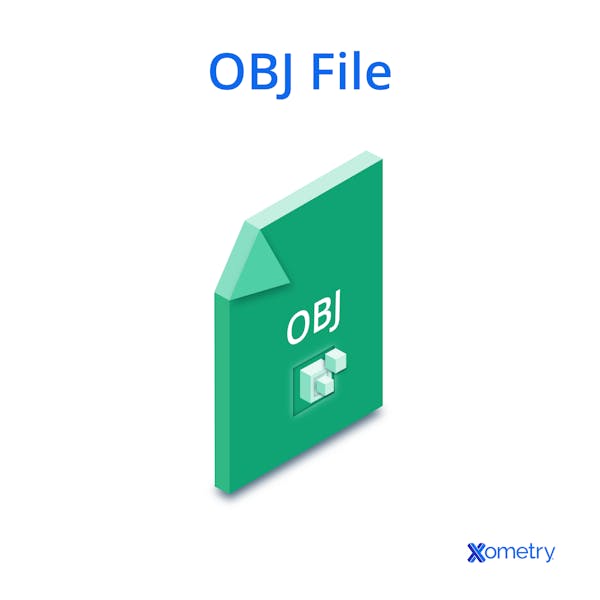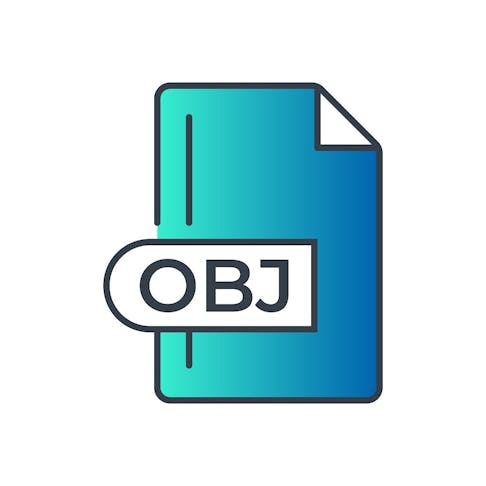In 1995, Wavefront Inc. launched a tool called Data Visualizer, which used the OBJ file type as its native format. The OBJ format is among the most trusted in 3D graphics applications. It has become the most widely used interchange format between 3D software, game design, and architectural visualization packages. A more recent and critical development is that OBJ has become the primary file format for multicolored 3D printing, directly interpreted by slicer software. Because of the high degree of interoperability, OBJ files can be opened in a vast range of software tools, from Paint 3D to advanced CAD, from Photoshop to Blender. Although Microsoft Paint 3D is the most universal tool for viewing OBJ files, OBJ models can also be saved from a wide range of visual and design software tools.
This article will discuss what an OBJ file format is, its history, its importance, and the applications for which it can be used.
What Is an OBJ File?
The OBJ file format is a widely used ASCII-based (text) 3D geometry format originally developed by Wavefront Technologies. It is well supported by 3D modeling software such as 3ds Max, Maya, Rhino, Blender, and many others. Additionally, it is compatible—with the help of plugins or import tools—with more engineering-focused CAD software like SolidWorks and FreeCAD. In recent years, the OBJ format has become increasingly important in 3D printing, particularly for creating full-color prototypes on advanced printers, as it supports not only geometry but also material definitions and texture mapping, enabling detailed and visually rich 3D models.
The OBJ file format supports detailed material definitions through associated .MTL (material) files enable precise control over surface properties, including color, reflectivity, transparency, and texture maps. It also includes support for texture vertices (also known as UV coordinates), which define a 2D texture mapping system for accurately wrapping images or patterns onto a 3D surface. One of the format's key strengths is its use of shared vertex lists, which helps maintain consistent mesh topology and reduces the likelihood of edge disjoints or gaps—a common issue in simpler formats like STL, which lack vertex indexing and texture data support. This makes OBJ especially useful for applications requiring visually rich and watertight models, such as animation, visualization, and full-color 3D printing.

Who Created the OBJ File Format?
The OBJ file format was initially developed by Wavefront Technologies in the 1980s as part of its Advanced Visualizer software package for 3D modeling and animation. In the early 1990s, Silicon Graphics Inc. (SGI) acquired both Wavefront Technologies and Alias Research, leading to the formation of Alias|Wavefront. This merger helped standardize the OBJ format as a standard interchange format in 3D graphics. In 2006, Autodesk acquired Alias Systems Corporation (the successor of Alias|Wavefront), and with it, continued support for the OBJ format. While Autodesk now owns many of the tools associated with the format, the OBJ file specification itself remains open and widely supported across the 3D software industry.
How To Convert an OBJ File
Converting an OBJ file depends on the software and the online tool used. This means that the OBJ file conversion varies from one tool to another. Because of the interoperability of OBJ files, many tools can open them. The OBJ file, once opened, can be converted into virtually any 3D format.
Check out our guide on How to Convert OBJ to STL Files.
How Do I Open an OBJ File?
Opening an OBJ file can be done under the following conditions:
- If you have compatible software installed (such as Adobe Photoshop, Paint 3D, Autodesk Maya, or various CAD applications), you can open an OBJ file by right-clicking it in File Explorer and selecting “Open with,” then choosing a supported program.
- If you need to convert the OBJ file to another format, install a recommended conversion tool (e.g., Blender, MeshLab, or dedicated 3D file converters), and follow the tool-specific instructions to open and convert the file.
One key factor to consider is that many proprietary 3D formats are designed with limited interoperability, often restricting conversion or usage outside their native ecosystem. For instance, the USDZ format is optimized for Apple's AR platform and is primarily supported on iOS and macOS, limiting its flexibility across platforms.
How Can I Make an OBJ File?
A typical export procedure for exporting an STL as an OBJ file looks like this, for FreeCAD:
- Select the solid you want to export.
- Click File>>Export and set the file type to OBJ
- Name the file (or default to the existing name), including the .OBJ extension.
- Click Save.
The creation of OBJ files is the result of save-as choices in the range of 3D design, visualization, and rendering packages, as a means to maintain interoperability between divergent platforms. As a result, when you save your work, you can transfer it into a specific software application like Rhino, SolidWorks, or GrabCAD, since the OBJ format is one of the options that will allow you to work on other packages or transfer data to a slicer.
What Is the Importance of OBJ Files?
OBJ files offer designers, modelers, 3D printers, and 3D environment builders some powerful options that make it a popular and relied-upon format. OBJ supports freeform curves as a method for defining surfaces. This allows mathematically precise definitions of curvature to create higher-quality surfaces than simple tessellation. Cardinal Splines and Bezier Curves reduce file sizes, define whole surfaces in mathematical terms, and reduce the overall quantity of data. Another key feature is that OBJ supports NURBS (Non-Uniform Rational B-Splines). This allows polygons to be defined from a surface that has been manually pulled and shaped by the designer. NURBS surfaces are processed automatically into mathematically precise data. Lastly, the OBJ format in 3D printing is attractive and offers a lower fault/gap count than STL. It has also become indispensable for color prints.
What Are the Types of OBJ Files?
The commonly used OBJ files are in ASCII format. The file contains command lines and # marked annotation lines, along with their associated elements.MTL files that travel with the .OBJ file. These files can contain extensive materials, textures, and color data, as well as complex mathematical descriptions of curved surfaces. But the contents follow a set of agreed format rules that are open source and almost entirely standardized.
OBJ files can also exist in binary format, often with the file type .MOD. The binary conversion of OBJ files, although open source, is not universally agreed upon. So OBJ binary files are often proprietary to applications and require some deep knowledge of the format and operation to be used.
What Are the Best OBJ File Converters?
File converters that can handle OBJ are plentiful and usually free. Below are some of the best OBJ file converters:
- AnyConv.com: AnyConv.com is a simple-to-use, quick, and powerful tool that can convert OBJ files into a limited range of the most commonly used formats—STL, DAE, FBX, GLTF, PLY, and more.
- Blender: Blender is a powerful design platform for modeling, sculpting, and video design. It also integrates a wide range of file conversion tools and works well with OBJ files.
- Autodesk Fusion: Autodesk Fusion is a powerful CAD/CAM and simulation tool that, while more complex to navigate, offers excellent OBJ handling and conversion capabilities. It is a professional tool that provides a free, limited-function version for home use.
What Are the Best Applications for OBJ Files?
Selecting which tool to use when the data is saved as an OBJ file depends on the nature of the 3D and the tasks to perform. Some of the best applications are:
- A character design tool, such as Blender or ZBrush.
- A product design package like FreeCAD.
- A repair/analysis tool like MeshMixer.
- A slicer to make ready OBJ files for 3D printing, like Cura.
Is an OBJ File the Same as a CAD File?
Yes, an OBJ file is the same as a CAD file. CAD systems define OBJ files as a universal interchange format. This is because OBJ files contain all the information that a typical CAD system requires to build precise and usable models in its workspace. On that basis, OBJ is a CAD format. However, its use is generally more focused on the “character and environment” part of the design spectrum in gaming, architecture, and video creation.
What Is the Difference Between an OBJ and an STL File?
Table 1 shows the differences between OBJ and STL formats:
For more information, see our guide on STL vs. OBJ.
| Property | OBJ | STL |
|---|---|---|
Property Vector x-y-z | OBJ ✔️ | STL ✔️ |
Property Vector normal (in/outside) | OBJ ✔️ | STL ✔️ |
Property Color attributes | OBJ ✔️ | STL ❌ (only supported in some non-standard binary STL variants; not in the widely used ASCII STL format) |
Property Texture attributes | OBJ ✔️ | STL ❌ |
Property Parameter space vertices | OBJ ✔️ | STL ❌ |
Property Line elements | OBJ ✔️ | STL ❌ |
Property Freeform curves to define surfaces (Cardinal, Bezier) | OBJ ✔️ | STL ❌ |
Property NURBS support | OBJ ✔️ | STL ❌ |
Property Relative AND absolute indices supported | OBJ ✔️ | STL ❌ |
At its core, STL was created as a way of communicating shape information for 3D objects. It contains no information about color, texture, material properties, or other attributes. This makes it a straightforward and robust format. OBJ, on the other hand, is a more complete and detailed definition of a 3D object. It allows detailed virtual rendering to make representations of objects colored, textured, and “real” looking. This requires a greater depth of properties to be integrated into the file structure, making the OBJ format considerably more capable and less fault-prone than STL.
Summary
This article provided a summary of the OBJ file format and discussed its origins, importance, applications, and how it differs from other file formats such as STL. To learn more about the OBJ file format and how it applies to your 3D printing project, contact a Xometry representative.
Xometry provides a wide range of manufacturing capabilities, including 3D printing and other value-added services for all of your prototyping and production needs. Visit our website to learn more or to request a free, no-obligation quote.
Disclaimer
The content appearing on this webpage is for informational purposes only. Xometry makes no representation or warranty of any kind, be it expressed or implied, as to the accuracy, completeness, or validity of the information. Any performance parameters, geometric tolerances, specific design features, quality and types of materials, or processes should not be inferred to represent what will be delivered by third-party suppliers or manufacturers through Xometry’s network. Buyers seeking quotes for parts are responsible for defining the specific requirements for those parts. Please refer to our terms and conditions for more information.


